|
|
Post by grrraaahhh on Apr 7, 2011 7:36:29 GMT -9
|
|
|
|
Post by grrraaahhh on Apr 13, 2011 19:11:16 GMT -9
North Slope Alaska (continued)"... Bears to close for comfort… Now is the time of year when the snow is melting off of the Coast range and I start thinking about heading off into the hills to see if I can scout out some bucks and bears. With green grass growing in the higher elevations, it isn’t unusual in the West to see hungry spring bears grazing and soaking up sun. Usually the bears I see will turn tail and run at the hint of human scent, but in wild places where people work alongside wildlife that isn’t always the case. It goes to show that wildlife can lose their fear of humans in their quest for an easy meal. Thanks to my Alaskan friend Mike Stark who sent me these pictures, he had an explanation to go with them… These pics are all from Prudhoe Bay Alaska, some of them have been around a while, still amazing though. The last pic is one of a bear they named Toby when he got into the Prudhoe Bay Hotel and up to the second floor. They decided that he was a little too used to humans and had to put him down..." 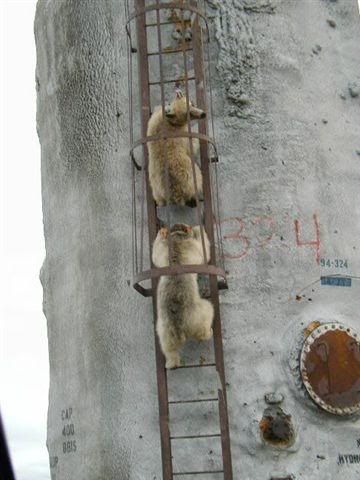  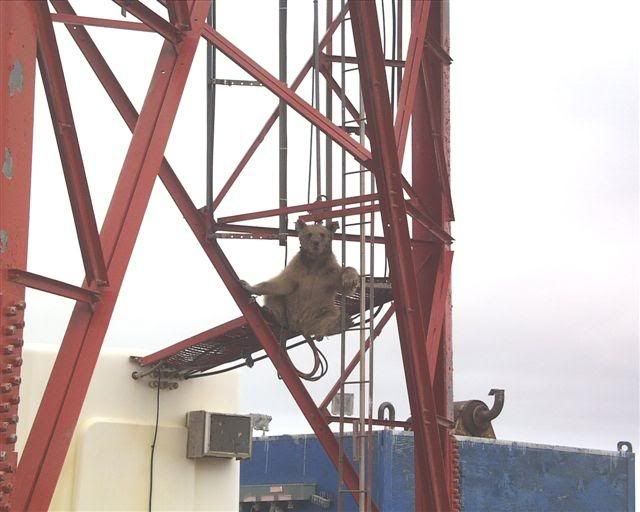 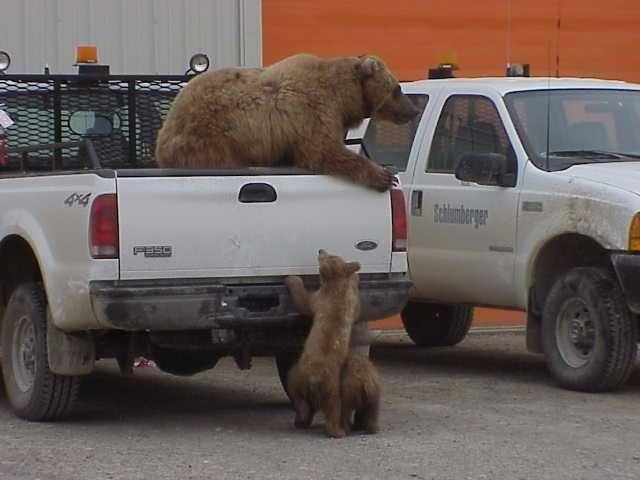 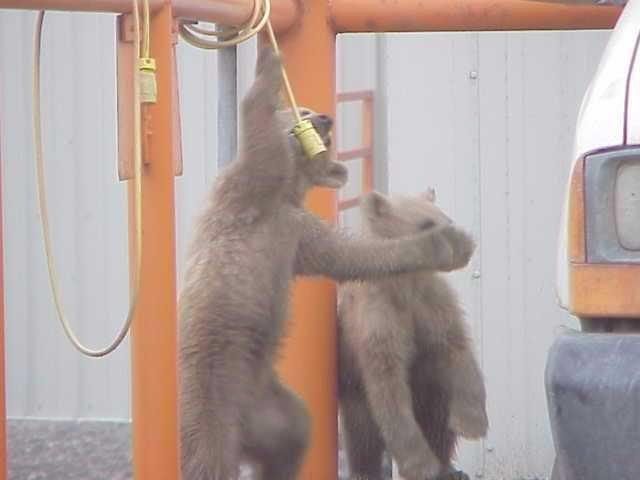  skinnymoose.com/racktracker/2008/06/06/bears-to-close-for-comfort/#comments skinnymoose.com/racktracker/2008/06/06/bears-to-close-for-comfort/#commentsOriginal post made by Warsaw.
|
|
|
|
Post by grrraaahhh on Apr 18, 2011 10:02:38 GMT -9
|
|
|
|
Post by grrraaahhh on May 23, 2011 10:33:40 GMT -9
Brooks RangeDeep in the arctic tundra interior, salmon runs are hard to locate. Witnesses to arctic grizzly bears salmon fishing are very rare but in a new US PBS series film makers were able to capture such an event. Bears of the Last Frontier
Hour 3: Arctic Wanderers: Video: The First Catch With help from its mother, a cub catches its first salmon at Brooks Range, high in the Alaskan Arctic. Watch video. Video clip link: www.pbs.org/wnet/nature/episodes/bears-of-the-last-frontier/hour-3-arctic-wanderers/video-the-first-catch/6994/To see more video footage, click on the relating PBS video links found at the PBS web site link or visit the forum EDUCATION & DOCUMENTARY VIDEO section.
|
|
|
|
Post by warsaw on May 24, 2011 0:06:43 GMT -9
Starving bear killed in Kugluktuk Wildlife officers in Kugluktuk made a disturbing discovery after they killed a malnourished three-year old grizzly bear that kept returning to community's dump. Wildlife officers invited high school and elementary school students to view the skinning, as a way of teaching students about why the bear was feeding at the dump and why it's important to keep bears away from town. When the wildlife officers cut open the bear's stomach, they found garbage such as plastic bags and gravel, a sign that the starving bear was desperate to eat. (SUMBITTED PHOTO)  www.nunatsiaqonline.ca/stories/article/0899_photo_starving_bear_killed_in_kugluktuk/ www.nunatsiaqonline.ca/stories/article/0899_photo_starving_bear_killed_in_kugluktuk/ |
|
|
|
Post by grrraaahhh on Apr 9, 2012 19:40:30 GMT -9
AbstractWe compared four nonlinear growth functions in modeling body length and mass size-at-age data for the brown bear (Ursus arctos L., 1758) in northern Canada of wide-ranging body sizes and ages. Then, we analyzed the sex differences in patterns of growth and ontogeny of sexual dimorphism in this species revealed by the best model from these alternatives. The von Bertalanffy function proved to be the most parsimonious model because it was easy to fit, with higher fitting degrees, lower root mean squared standard deviation of data points about fitted growth curve, larger Akaike weight, and fewer parameters derived directly from metabolic laws that accurately estimated the observed body length and mass growth profiles. Our growth models indicated an association between sexual growth divergence and the onset of reproduction in females, together with more rapid and prolonged male growth. These findings suggest that sexual size dimorphism develops in part by constraints on female growth from high energetic costs of reproduction. In contrast, males do not experience a comparable energetic trade-off after reaching sexual maturity and apparently allocate available energetic resources to growing faster and longer to produce larger body size, which benefits more competitive males in terms of increased reproductive success. Bartareau, T.M.; Cluff, H.D.; Larter, N.C. Body length and mass growth of the brown bear ( Ursus arctos) in northern Canada: model selection based on information theory and ontogeny of sexual size dimorphism. Canadian Journal of Zoology, 2011, 89 (11): 1128-1135. www.nrcresearchpress.com/doi/abs/10.1139/z11-088
|
|
|
|
Post by grrraaahhh on Apr 10, 2012 9:47:18 GMT -9
|
|
|
|
Post by warsaw on Apr 28, 2012 10:09:14 GMT -9
Barren-ground Grizzly Bear
Shot in Yellowknife, NWT
Dean Cluff
Resources, Wildlife and
Economic Development
North Slave Region
Government of the
Northwest Territories
Yellowknife, NT X1A 2P9, Canada
Subadult male grizzly bear (3-5 years
of age) movements have been noted to
exhibit periods of long-range (>200 km)
linear directional forays (see Gau et al.
2004). However of the 229 barrenground
grizzlies the Government of the
NWT has handled since 1988, G608 has
been the only female known to exhibit
extraordinary periods of linear longrange
movement patterns. In 2000,
G608 went on a 1,792 km round-trip
trek between June 20 and October 10 to
an area 240 km to the east of her original
capture and back again. In 2001, she
went on a 1,541 km circular round-trip
trek between July 1 and September 30
moving 160 km to the north then
clockwise to an area 200 km to the
southeast until she returned to her
original capture area. To put this into
perspective, again, a trip from San
Diego to San Francisco and back to San
Diego is roughly 1,615 km. Finally in
2002, G608 went on a 150 km trek
between July 14 and July 22 to an area
56 km to the north.
The annual ranges of adult and
subadult barren-ground grizzly bears in
the central Canadian Arctic remain the
largest ranges reported for grizzlies in
North America (see Table 1, McLoughlin
et al. 1999). However, the unique feature
of G608’s movements was their occasional
linear directionality, a trait shared
with subadult males in the region, albeit
the magnitude of G608’s movements in
2000 and 2001 eclipse those of any other
bear ever collared in the region.
Literature Cited:
Gau, R.J., McLoughlin, P.D., Case,
R., Cluff, H.D., Mulders, R., and
Messier, F. 2004. Movements of
subadult male grizzly bears, Ursus
arctos, in the central Canadian Arctic.
Canadian Field-Naturalist 118:in press.
McLoughlin, P.D., Case, R.L., Gau,
R.J., Ferguson, S., and Messier, F. 1999.
Annual and seasonal movement
patterns of barren-ground grizzly bears
in the central Northwest Territories.
Ursus 11:79-86
A 220-kg male barren-ground
grizzly bear was killed in Yellowknife
on 18 November 2004. This was the
first recorded occurrence of a grizzly
bear near the city (population
18,000) and was unusual for a
sighting this far (170 km) from the
tundra. Indeed, an 85 year-old Dene
elder from the nearby community of
Detah does not recall ever hearing of
a grizzly bear in the area.The bear
was shot by wildlife officers pursuing
the animal at the outskirts of the
city. The bear was sighted the
previous night near Detah and again
the following morning when the
bear then crossed the ice of
Yellowknife Bay of Great Slave Lake
towards Yellowknife. Wildlife
officers then intercepted its tracks
along the city’s lakeshore. When
encountered, the bear charged the
officers from about 10 m, which led
to its shooting.
A necropsy of the bear revealed
about 1 cm of back fat and insufficient
to take it through the winter.
Cysts, possibly from pneumonia,
were discovered on the lungs and
several porcupine quills observed on
one of its legs and the side of his face
had become infected. Tooth wear was
heavy and a small pre-molar was
extracted for subsequent aging by
cementum analysis.
The grizzly bear presumably
followed the migratory barrenground
caribou south beyond the
tree-line as caribou made their way
to their winter range. In early
November, sightings of large bear
tracks were first reported 70 km east
of Yellowknife on the Ingraham Trail
but it was uncertain then if the
tracks were from a grizzly bear or a
large American black bear. However,
on 7 November, sightings of a brown
colored bear with a hump were
reported along the Trail but now
about 50 km east of Yellowknife. No
other sightings of bears have been
reported since this grizzly bear was
shot in Yellowknife. Consequently, it
is likely that these sightings were of
this bear as it moved towards the city
while searching for food.
Barren-ground grizzly bears do
occupy a narrow band south of the
tree-line but sightings farther south
are rare. Grizzly bears have been seen
regularly in the community of
Wekweti about 30 km from the
tundra. Other sightings of grizzly
bears within the boreal forest include
the Fort Reliance area and the now
closed Colomac mine site, about 25
and 70 km respectively from the
tundra. On 24 May 2003, Rob Gau
and I observed grizzly bear tracks at
an unoccupied mining camp at the
headwaters of the McCrea River, 45
km south of the tree-line. In June
1997, a young male barren-ground
grizzly bear was shot near Gameti,
about 185 km from the tundra.
Although the Gameti and
Yellowknife incidences represent the
farthest reported distances of barrenground
grizzly bears within the
boreal forest, they are consistent
with these bears following the
Bathurst caribou herd to winter
ranges in late fall
|
|
|
|
Post by grrraaahhh on Jul 22, 2012 8:37:49 GMT -9
Northwestern Alaska (continued)
|
|
|
|
Post by grrraaahhh on Jul 23, 2012 3:32:30 GMT -9
Northwestern Alaska (continued)Northwestern Alaska (continued) 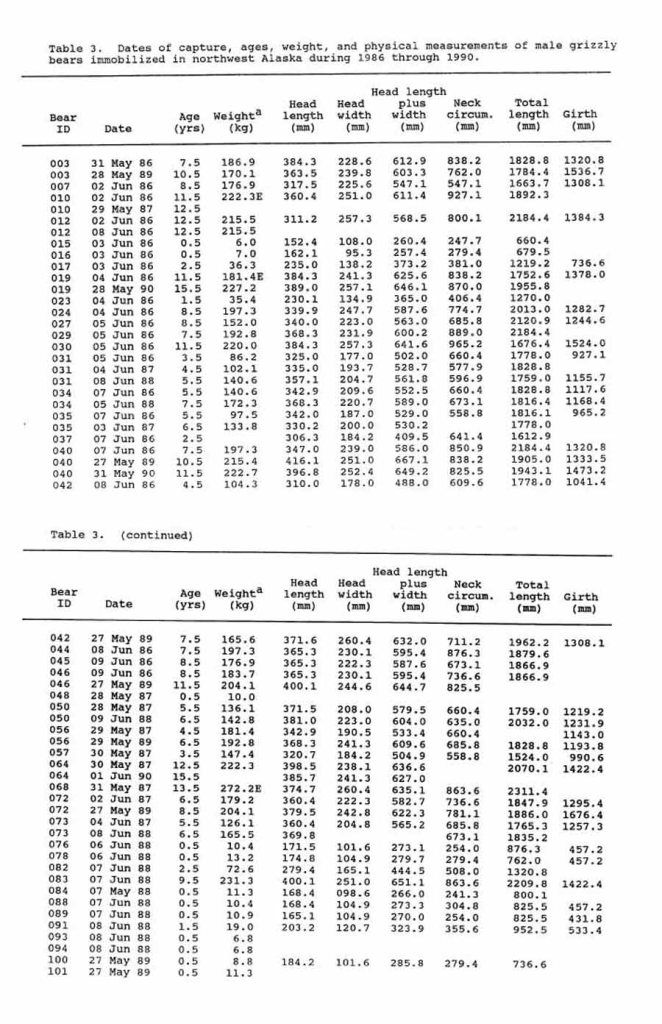 Source: Source: BALLARD, W.B. 1987. Demography of Noatak grizzly bears in relation to human exploitation and mining development. Alas. Dep. Fish and Game, Fed. Aid in Wildl. Restoration Prog. Rep. Proj. W-22-5 and W-22-6. Juneau. 45pp.  Source: Source: Ballard et, al. (1987).
|
|
|
|
Post by grrraaahhh on Jul 23, 2012 3:40:22 GMT -9
Northwestern Alaska (continued)Northwestern Alaska (continued)  Source: Source: BALLARD, W.B. 1987. Demography of Noatak grizzly bears in relation to human exploitation and mining development. Alas. Dep. Fish and Game, Fed. Aid in Wildl. Restoration Prog. Rep. Proj. W-22-5 and W-22-6. Juneau. 45pp.  Source: Source: Ballard et, al. (1987).
|
|
|
|
Post by warsaw on Dec 30, 2012 11:21:30 GMT -9
|
|